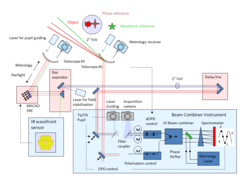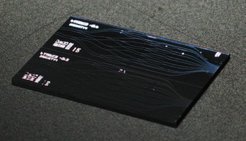Instrument
Adaptive optics assisted interferometric imaging and astrometry
GRAVITY provides high-precision narrow-angle astrometry and phase-referenced interferometric imaging in the astronomical K-band (2.2 µm). It combines the light from four UTs or ATs, measuring simultaneously the stellar interferograms from six baselines. The instrument has three main components: the infrared wavefront sensors, the beam combiner instrument, and the laser metrology. Figure 3 gives an overview of GRAVITY. For clarity, only two of four telescopes – i.e. one out of six baselines – are shown.

Figure 1: GRAVITY overview. The beam combiner instrument (bottom right) is located in the VLTI laboratory. The infrared wavefront-sensors (bottom left) are mounted to each of the four UTs. The laser metrology is launched from the beam-combiner and is detected at each UT/AT (top middle).
The GRAVITY infrared wavefront sensors are mounted in the Coudé rooms of the UTs and will command the existing MACAO deformable mirrors. The system can work on either of the two beams (on-axis or off-axis) behind the PRIMA star separators. Any additional tip/tilt from the beam-relay down to the VLTI laboratory is corrected by a dedicated laser guiding system. Low-frequency drifts of the field and pupil are corrected by the GRAVITY-internal acquisition and guiding camera. The interplay of these systems guarantees an unperturbed and seeing-corrected beam at the entrance of the beam combiner instrument in the VLTI lab. The interferometric instrument will work on the 2-arcsecond (UT) rsp. 4-arcsecond (AT) VLTI field of view. Both reference star and science object reside within this field of view. The light of the two objects from the four telescopes is coupled into optical fibers for modal filtering, compensation of differential delay, and adjustment of polarization. The fibers feed two integrated optics beam combiners. The coherently combined light is dispersed in two spectrometers. A low-resolution spectrometer provides internal phase and group delay tracking on the reference star, and thus enables long exposure times on the science target. Three spectral resolutions with up to R ~ 4,000 are implemented in the science spectrometer, and a Wollaston prism provides basic polarimetry. GRAVITY simultaneously measures the visibility of the reference star and of the science object for all spectral channels, and the differential phase between the two objects. This information is used for interferometric imaging exploring the complex visibilities, and for astrometry using the differential phase and group delay. All functions of the GRAVITY beam combiner instrument are implemented in a single cryostat for optimum stability, cleanliness, and thermal background suppression. The internal path lengths of the VLTI and GRAVITY are monitored with a dedicated laser metrology. The laser light is back-propagated from the beam combiner and covers the full beam up to the telescope spider above the primary mirrors.
Hightlights from the instrumental developement
The detailed description of GRAVITY’s subsystems can be found in GRAVITY Collaboration et al. 2017. We present a few highlights in brief: the world’s first K-band (2.2 µm) integrated optics beam combiner for four telescopes, a high-speed photon-counting infrared detector, and a novel laser metrology concept.
GRAVITY's beam combiner is an integrated optics chip, the optical equivalent of a microelectronic circuit, which combines several functions in a single component. It benefits from the advantages of compactness and stability, and provides outstanding visibility accuracies. Integrated optics is widely used in telecommunication up to 1.6 µm, but does not cover the astronomically interesting K-band at 2.2 µm. GRAVITY has thus launched its own development program between IPAG, LETI, and CIP to port the technology to longer wavelengths. Following a series of prototypes implementing individual functions, we have now the world’s first K-band integrated optics beam combiner for four telescopes in hand (Figure 2).
The second major breakthrough for GRAVITY is the recent success in the development of high-speed infrared photon-counting detector arrays. All current astronomical infrared fringe tracker and wavefront sensors suffer from the comparably high noise of their detectors, which is ten or more electrons per pixel at few hundred Hertz frame rates. The GRAVITY detectors overcome this noise barrier by avalanche amplification of the photoelectrons inside the pixels. In 2016, SELEX-Galileo (now LEONARDO) and ESO demonstrated for the first time a read noise of less than three electrons with their prototype detector array. Based on this success, ESO and SELEX developed the SAPHIRA detectors for GRAVITY's wavefront sensor and fringe tracker.

Figure 2: Recent break-through in integrated optics used in GRAVITY.
Another example of a major breakthrough is the GRAVITY laser metrology. It is based on a novel concept to trace the starlight throughout the observatory, and allows us to measure the optical path at every desired point of the pupil and to easily get up to above the primary mirror.

